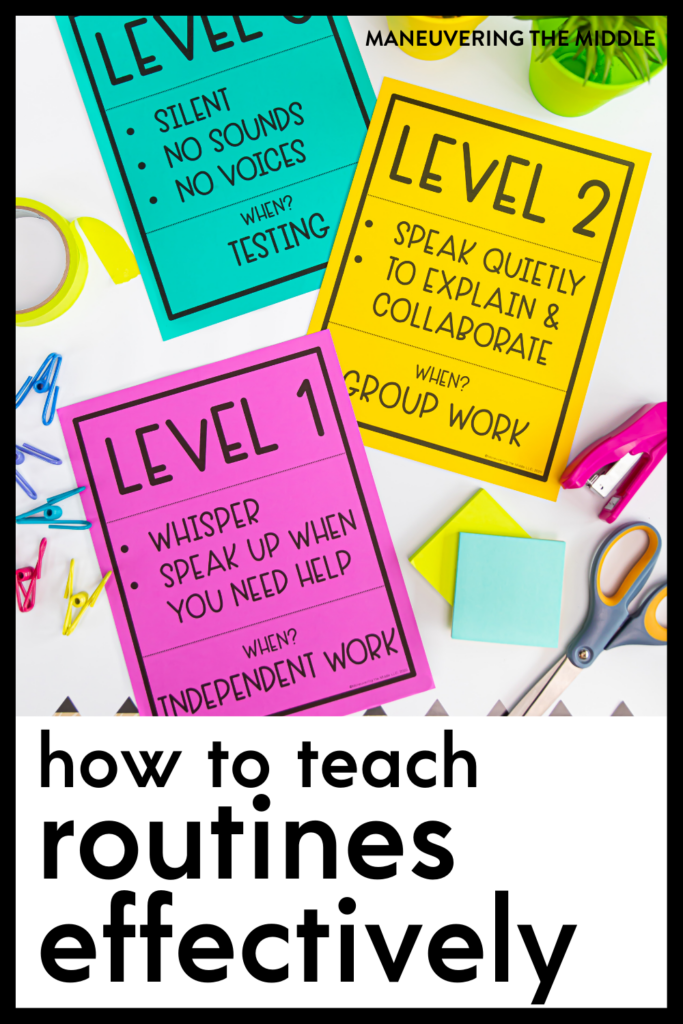You may have the best routines and procedures planned for your classroom, but if you don’t effectively teach students HOW to implement those routines, then you and your students will not reap the benefits of time and energy saved.
LISTEN ON: APPLE PODCAST | SPOTIFY

Step 1: Brainstorm the Routines You Want to Teach
The first thing you as the teacher need to do is KNOW all of the routines and procedures you want to teach.
Brainstorm all the things that you plan to frequently do in your classroom. Do you plan to use stations throughout the year? Do you have devices that need to be picked up on a daily basis?
Think through the things that will happen regularly in your classroom.
Once you have your list of routines and procedures that you want to teach, plan situations in which these routines and procedures can be taught.
Then, I like to group these into days and what makes sense to teach together. For example, teach the procedures for stations on a day where they will go to stations. Shorten the content of each station to build in time for practicing rotating and cleaning up after themselves.
Step 2: Students Need to Practice the Routine
You want to chunk this into three parts — modeling and explanation, student practice, feedback, and then repeat. And repeat a few more times after that.
As a teacher, I liked to model the routine in the most dramatic fashion. I could get pretty comedic doing a non-example.
Let’s look at collecting and turning in papers. Without much direction, this can lead to chaos, a line of students at the turn-in bin, and the messiest turn-in tray you have ever seen.
So here is an example you may consider teaching.
- Students check that their name is on their paper
- Students hand their papers to the table captain
- Table captain makes sure that all of the papers are facing the correct direction, and then passes the papers to the next table. The pile moves to the front of the classroom.
Then, you could time them to see if they could do it in less than a minute…or any arbitrary time. Timing makes it a little more exciting and can bring some healthy competition between class periods. Once all the papers make it to the correct spot, ask students how they could improve on their time. Then, pass those papers back to them to try again. Simple but effective!
What routines can my students benefit from immediate practice with feedback?
Step 3: Get Student Buy-In
Share the why! A functioning classroom allows for more time to learn and, more specifically, more time to do fun things!
Another way to gain student buy-in, is to ask students their opinion. For the routines and class expectations that you don’t feel strongly about, you can cultivate students’ buy-in by asking them what they think. This can be as meaty as – how do we show respect to the teacher, the school, and the other students in the classroom? Create a list of do’s and don’ts that are brainstormed together.
Or it can be as light as – what’s the best way to ask for help?
Students always surprise me with their perspectives. And this helps foster a strong sense of community when students’ voices are heard.
You could facilitate a gallery walk. Place large white paper around the room with questions you want students’ input on. Students walk around the room and write their ideas. Students can put checks by ideas they like to show their support.
Step 4: Have Students Teach It
Get students involved by having them teach the routine, procedure or policy to each other.
Speed Dating or a JigSaw are two fun ways to incorporate collaboration.
If you aren’t familiar with a jig saw, here it is:
- Break students up into 5 or so groups. (Number of groups will depend on how many routines/procedures you want students to learn)
- Each group is responsible for learning a routine and procedure. They could do this by reading a syllabus or student handbook. Group A reads about the late work policy, Group B learns about how to get supplies, and Group C reads about the phone policy, etc.
- Set a timer, and then have students make new groups consisting of one member from each previous group – So now, one group consists of someone from Group A, B, and C. Each group member shares what they learned to the other members of the group.
If you do decide to have students teach the procedure, then you want to make sure to allow time to go over it together at the end. A Kahoot or a Quizizz is a great way to do this because students get immediate feedback and you can clarify what the expectation is.

Point 5: Reflect, Revise, and Repeat
Reflect, revise, and repeat!
The beauty of teaching is that each year you get a fresh start, so it is really important to reflect on the way the routine or procedure was taught, see how well it is sticking, and then revise it as the year progresses. This can be as simple as saying, “I have noticed that when we pick up materials as we come into the classroom it is causing a big build up of students in the doorway, instead we are going to…”
Don’t be afraid to tweak or change anything that isn’t working. Just be consistent in what you have taught and follow through with those procedures.
Consistency is key in teaching and classroom management…and as teachers we can build our consistency muscle though routines and procedures.





